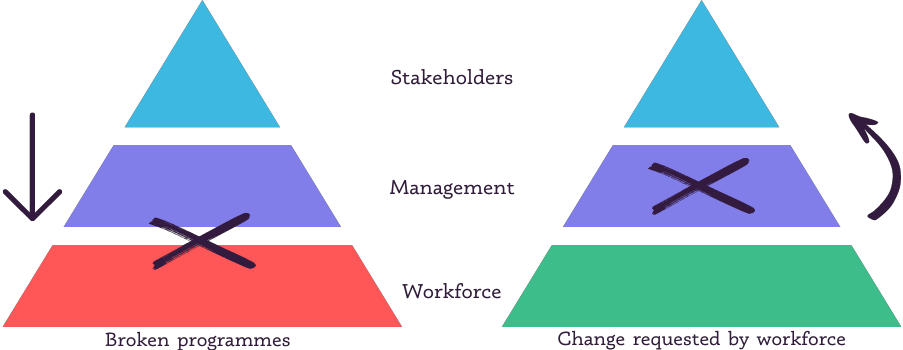Organizations are constantly changing, evolving, and adapting to meet new challenges, provide new services or simply improve existing processes. Change is constant, with 70% of companies saying they either have a digital transformation strategy in place or are working on one. However, change may not be so easy, as changing the way an organization thinks and acts may involve changing the way hundreds, or thousands, of employees think and act.
71% of leaders say the workforce is important in supporting their digital transformation strategy, so how does an organization implement change? That’s when change management comes in.
What is change management?
Change management definition
Change management is defined as the planning and introduction of new processes, methods of working, etc. in a company or organization. Change management prepares and helps individuals, teams, and businesses to make and undergo organizational change.
Why is change management important
A change management process is necessary to support people and teams affected by changes in the organization, including new technology solutions, internal processes, competitive pressure, restructuring, and crisis response. Successful change management is key to any new implementation.
Organizational change issues
Change management example: new software implementation

Typically within an organization, once the decision of implementing a new piece of software has been taken by stakeholders, even though the financial benefits can be enormous, the role of implementation is immediately delegated to either management or contractors. They, in turn, are responsible for winning the hearts and minds of everyone in the workforce to adopt the technology. It is at this stage that normally programs will break down when the users are forced to use new technologies without context or a reason why they should be using it.
Management is met with resistance causing low or partial use of the software. This leads to all the great reasons for implementing the software not being achieved.
A paradigm shift. With the advent of newer technologies in recent years, there is a huge opportunity to change the way we implement programs of change. By working with the user base to establish context, understanding the ‘why?’ and getting wholesale commitment, the pyramid can now reverse, with the workforce being the one requesting the change from management – ‘a pull’ rather than ‘a push’.
Use of simulations for change management
Experiential learning as an organizational change method
Experiential learning is likely to become a dominant part of the solution to many organizational change issues. Business simulations use behavioral dynamics and game technologies to drive user acceptance and collaboration by ensuring that systems integration is their own idea rather than someone else’s. This allows workforces to come up with solutions to the organization’s problems for themselves by establishing a common goal and putting them in the driving seat, instead of being forced to use new approaches.
Simulations have been proven to improve the following:
1. Employee engagement
Employee engagement is the most important factor when it comes to organizational change. 71% of businesses executives surveyed by The Harvard Review Analytic Services ranked employee engagement as very important to achieving business success. Businesses with engaged employees are more successful, thus more profitable.
2. Accelerated learning
Due to the nature of the experiential approach, participants own the change and learn by doing. This creates longer-lasting connections, as they put into practice a skill and apply it to real-life situations, emphasizing more on the practice than the theory of the learning process.
3. Learning from failure
Experiential learning encourages trying different approaches to succeed. By simulating real-life businesses and issues, participants have the opportunity to test and improve their skills in a safe environment that, although realistic, has no impact on the real business. Practice, indeed, makes perfect.
4. Opportunities for reflection
Simulations allow participants to reflect on their decisions and recognize how these affect the outcome. This encourages them to analyze their actions and explore how they could have a different impact. After all, in simulations, no children and animals get hurt.
5. Importance of preparation
Participants have an improved understanding of the importance of preparation and appropriate governance around change. This helps them to understand the need for change, raising awareness of the challenges the organization is facing. Gaining this awareness allows them to then request the change to stakeholders.
Change management business simulations
If you are thinking about implementing change within your business, make your workforce the first thing you think about rather than the last.
Using business simulation games is one of the most effective ways to drive transformation and accelerate organizational success. Simulations such as ChangeManagement.Inc will allow you to upskill and switch on your workforce.
If you want to know more about our experiential learning simulations and ChangeManagement.Inc, please contact us or book a demo.

